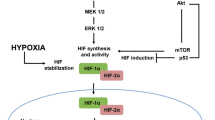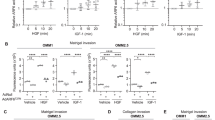Abstract
Hypoxia and its down-stream activated pathways are commonly involved in tumor progression. Genes involved in angiogenesis and glycolysis, i.e. vascular endothelial growth factor (VEGF) and lactase dehydrogenase A (LDHA), respectively, are transcriptionally controlled by the hypoxia inducible factors 1α and 2α (HIF1α and HIF2α). A series of 60 uveal melanomas were immunohistochemically assessed for the expression of VEGF and the phosphorylated/activated form of VEGF receptor 2 (pVEGFR2/KDR), after binding to VEGF. The expression of HIF1α, HIF2α and LDH5 was also investigated. Uveal melanomas overexpressing HIF2α (but not that of HIF1α) were significantly associated with high VEGF (P = 0.005), pVEGFR2/KDR (P < 0.0001) and LDH5 (P ≤ 0.0001). High LDH5 was linked with tumor necrosis (P = 0.01) and increased tumor size (P = 0.03). High VEGF was linked with phosphorylated pVEGFR2/KDR receptors. In univariate analysis high pVEGFR2/KDR receptor expression was significantly related with poor prognosis (P = 0.02). It is concluded that HIF2α plays an important role in the progression of uveal melanomas possibly by promoting the autocrine loop VEGF-pVEGFR2/KDR, and by enhancing the expression of LDHA gene, conferring thus a growth advantage. As pVEGFR2/KDR expression was significantly related with poor prognosis, inhibitors of this receptor may improve the clinical outcome of patients with pVEGFR2/KDR overexpressing uveal melanomas.


Similar content being viewed by others
References
Lutz JM, Cree IA, Foss AJ (1999) Risk factors for intraocular melanoma and occupational exposure. Br J Ophthalmol 83:1190–1193
Gragoudas E, Li W et al (2002) Evidence-based estimates of outcome in patients irradiated for intraocular melanoma. Arch Ophthalmol 120(12):1665–1671
Bechrakis NE, Schmid E et al (2010) Proton beam irradiation of uveal melanomas of the posterior pole. Spektrum Augenheilkd 24:11–16
Bechrakis NE, Petousis V, Willerding G et al (2010) Ten-year results of transscleral resection of large uveal melanomas: local tumour control and metastatic rate. Br J Ophthalmol. 94:460–466
Yang AS, Chapman PB (2009) The history and future of chemotherapy for melanoma. Hematol Oncol Clin North Am 23:583–597
Ascierto PA, Kirkwood JM (2008) Adjuvant therapy of melanoma with interferon: lessons of the past decade. J Transl Med 6:62
Michaylira CZ, Nakagawa H (2006) Hypoxic microenvironment as a cradle for melanoma development and progression. Cancer Biol Ther 5:476–479
Bedogni B, Powell MB (2009) Hypoxia, melanocytes and melanoma - survival and tumor development in the permissive microenvironment of the skin. Pigment Cell Melanoma Res 22:166–174
Giatromanolaki A, Sivridis E, Kouskoukis C et al (2003) Hypoxia-inducible factors 1alpha and 2alpha are related to vascular endothelial growth factor expression and a poorer prognosis in nodular malignant melanomas of the skin. Melanoma Res 13:493–501
Forsythe JA, Jiang BH, Iyer NV et al (1996) Activation of vascular endothelial growth factor gene transcription by hypoxia-inducible factor 1. Mol Cell Biol 16:4013–4604
Blancher C, Moore JW, Talks KL et al (2000) Relationship of hypoxia-inducible factor (HIF)-1alpha and HIF-2alpha expression to vascular endothelial growth factor induction and hypoxia survival in human breast cancer cell lines. Cancer Res 60:7106–7113
Semenza GL, Jiang BH, Leung SW et al (1996) Hypoxia response elements in the aldolase A, enolase 1, and lactate dehydrogenase A gene promoters contain essential binding sites for hypoxia-inducible factor 1. J Biol Chem 271:32529–32537
Stewart M, Turley H, Cook N et al (2003) The angiogenic receptor KDR is widely distributed in human tissues and tumours and relocates intracellularly on phosphorylation. An immunohistochemical study. Histopathology 43:33–39
Edge SD, Byrd DR, Carducci MA, Compton CC (eds) (2010) AJCC cancer staging manual, 7th edn. Springer, New York
Talks KL, Turley H, Gatter KC et al (2000) The expression and distribution of the hypoxia-inducible factors HIF-1alpha and HIF-2alpha in normal human tissues, cancers, and tumor-associated macrophages. Am J Pathol 157:411–421
Koukourakis MI, Giatromanolaki A, Sivridis E et al (2006) Tumour Angiogenesis Research Group. Lactate dehydrogenase 5 expression in operable colorectal cancer: strong association with survival and activated vascular endothelial growth factor pathway—a report of the Tumour Angiogenesis Research Group. J Clin Oncol 24:4301–4308
Turley H, Scott PA, Watts VM et al (2005) Expression of VEGF in routinely fixed material using a new monoclonal antibody VG1. J Pathol 186:313–318
Liu J, Qu R, Ogura M et al (2005) Real-time imaging of hypoxia-inducible factor-1 activity in tumor xenografts. J Radiat Res 46:93–102
Victor N, Ivy A, Jiang BH et al (2006) Involvement of HIF-1 in invasion of Mum2B uveal melanoma cells. Clin Exp Metastasis 23:87–96
Liu Y, Tao J, Li Y, Yang J et al (2009) Targeting hypoxia-inducible factor-1alpha with Tf-PEI-shRNA complex via transferrin receptor-mediated endocytosis inhibits melanoma growth. Mol Ther 17:269–277
el Filali M, Missotten GS, Maat W et al (2010) Regulation of VEGF-A in uveal melanoma. Invest Ophthalmol Vis Sci 51:2329–2337
Valencak J, Kittler H, Schmid K et al (2009) Prognostic relevance of hypoxia inducible factor-1alpha expression in patients with melanoma. Clin Exp Dermatol 34:e962–e964
Young AC, Craven RA, Cohen D et al (2009) Analysis of VHL Gene Alterations and their Relationship to Clinical Parameters in Sporadic Conventional Renal Cell Carcinoma. Clin Cancer Res 15:7582–7592
Steiner H, Berger AP, Godoy-Tundidor S et al (2004) An autocrine loop for vascular endothelial growth factor is established in prostate cancer cells generated after prolonged treatment with interleukin 6. Eur J Cancer 40:1066–1072
Bachelder RE, Wendt MA, Mercurio AM. Vascular endothelial growth factor promotes breast carcinoma invasion in an autocrine manner by regulating the chemokine receptor CXCR4. Cancer Res 62:7203-7206
Kim SJ, Seo JH, Lee YJ et al (2005) Autocrine vascular endothelial growth factor/vascular endothelial growth factor receptor-2 growth pathway represents a cyclooxygenase-2-independent target for the cyclooxygenase-2 inhibitor NS-398 in colon cancer cells. Oncology 68:204–211
Le A, Cooper CR, Gouw AM et al (2010) Inhibition of lactate dehydrogenase A induces oxidative stress and inhibits tumor progression. Proc Natl Acad Sci USA 107:2037–2042
Boyd SR, Tan DS, de Souza L et al (2006) Uveal melanomas express vascular endothelial growth factor and basic fibroblast growth factor and support endothelial cell growth. 1. Br J Ophthalmol 86:440–447
Missotten GS, Notting IC, Schlingemann RO et al (2006) Vascular endothelial growth factor a in eyes with uveal melanoma. 1. Arch Ophthalmol 124:1428–1434
Barak V, Pe’er J, Kalickman I et al (2011) VEGF as a biomarker for metastatic uveal melanoma in humans. 1. Curr Eye Res 36:386–390
Flanigan J, Deshpande H, Gettinger S (2010) Current status of vandetanib (ZD6474) in the treatment of non-small cell lung cancer. Biologics 4:237–243
Stadler WM, Cao D, Vogelzang NJ et al (2004) A randomized Phase II trial of the antiangiogenic agent SU5416 in hormone-refractory prostate cancer. Clin Cancer Res 10:3365–3370
Banerjee S, A’Hern R, Detre S et al (2010) Biological evidence for dual antiangiogenic-antiaromatase activity of the VEGFR inhibitor PTK787/ZK222584 in vivo. Clin Cancer Res 16:4178–4187
Author information
Authors and Affiliations
Corresponding author
Rights and permissions
About this article
Cite this article
Giatromanolaki, A., Sivridis, E., Bechrakis, N.E. et al. Phosphorylated pVEGFR2/KDR receptor expression in uveal melanomas: relation with HIF2α and survival. Clin Exp Metastasis 29, 11–17 (2012). https://doi.org/10.1007/s10585-011-9424-6
Received:
Accepted:
Published:
Issue Date:
DOI: https://doi.org/10.1007/s10585-011-9424-6




